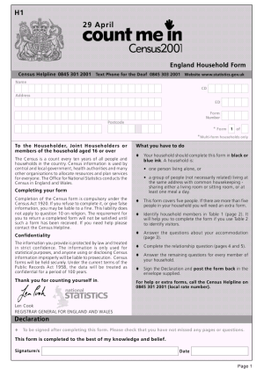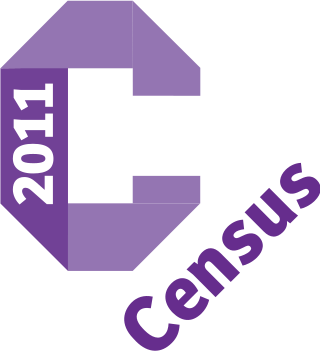Related Research Articles

Demographics of Wales include the numbers in population, place of birth, age, ethnicity, religion, and number of marriages in Wales.
The Office for National Statistics is the executive office of the UK Statistics Authority, a non-ministerial department which reports directly to the UK Parliament.

The Survey of Income and Program Participation (SIPP) is a statistical survey conducted by the U.S. Census Bureau. The SIPP is designed to provide accurate and comprehensive information about the incomes of American individuals and households and their participation in income transfer programs.

Eurostat is a Directorate-General of the European Commission located in the Kirchberg quarter of Luxembourg City, Luxembourg. Eurostat's main responsibilities are to provide statistical information to the institutions of the European Union (EU) and to promote the harmonisation of statistical methods across its member states and candidates for accession as well as EFTA countries. The organisations in the different countries that cooperate with Eurostat are summarised under the concept of the European Statistical System.

Religion in the United Kingdom, and in the countries that preceded it, has been dominated for over 1,400 years by various forms of Christianity, replacing Romano-British religions, Celtic and Anglo-Saxon paganism as the primary religion. Religious affiliations of United Kingdom citizens are recorded by regular surveys, the four major ones being the national decennial census, the Labour Force Survey, the British Social Attitudes survey and the European Social Survey.

Coincident full censuses have taken place in the different jurisdictions of the United Kingdom every ten years since 1801, with the exceptions of 1941, Ireland in 1921/Northern Ireland in 1931, and Scotland in 2021. In addition to providing detailed information about national demographics, the results of the census play an important part in the calculation of resource allocation to regional and local service providers by the UK government.
The foreign-born population of the United Kingdom includes immigrants from a wide range of countries who are resident in the United Kingdom. In the period January to December 2016, there were groups from 22 foreign countries that were estimated to consist of at least 100,000 individuals residing in the UK.
The Family Resources Survey (FRS) is one of the United Kingdom’s largest household surveys. It is carried out by the Office for National Statistics (ONS) with the National Centre for Social Research (NatCen), and Northern Ireland Statistics and Research Agency (NISRA) on an annual basis, by collecting information on the incomes and characteristics of private households in the United Kingdom. It is sponsored by the Department for Work and Pensions (DWP).

The demography of London is analysed by the Office for National Statistics and data is produced for each of the Greater London wards, the City of London and the 32 London boroughs, the Inner London and Outer London statistical sub-regions, each of the Parliamentary constituencies in London, and for all of Greater London as a whole. Additionally, data is produced for the Greater London Urban Area. Statistical information is produced about the size and geographical breakdown of the population, the number of people entering and leaving country and the number of people in each demographic subgroup. The total population of London as of 2021 is 8,799,800.
The Neighbourhood Statistics Service (NeSS) was established in 2001 by the UK's Office for National Statistics (ONS) and the Neighbourhood Renewal Unit (NRU) - then part of the Office of the Deputy Prime Minister (ODPM), now Communities and Local Government (CLG) - to provide good quality small area data to support the Government's Neighbourhood Renewal agenda. This cross-Government initiative also involved the co-operation and partnership of data suppliers across departments, agencies and other organisations. The ONS closed the Neighbourhood Statistics website for England and Wales on the 12 May 2017. To offset this, the ONS is aiming to meet the needs of users via the ONS website, although direct postcode searches are no longer available to users.

Median household disposable income in the UK was £29,400 in the financial year ending (FYE) 2019, up 1.4% (£400) compared with growth over recent years; median income grew by an average of 0.7% per year between FYE 2017 and FYE 2019, compared with 2.8% between FYE 2013 and FYE 2017.
The UK Statistics Authority is a non-ministerial government department of the Government of the United Kingdom responsible for oversight of the Office for National Statistics, maintaining a national code of practice for official statistics, and accrediting statistics that comply with the Code as National Statistics. UKSA was established on 1 April 2008 by the Statistics and Registration Service Act 2007, and is directly accountable to the Parliament of the United Kingdom.
Labour Force Surveys are statistical surveys conducted in a number of countries designed to capture data about the labour market. All European Union member states are required to conduct a Labour Force Survey annually. Labour Force Surveys are also carried out in some non-EU countries. They are used to calculate the International Labour Organization (ILO)-defined unemployment rate. The ILO agrees the definitions and concepts employed in Labour Force Surveys.

A census of the population of the United Kingdom is taken every ten years. The 2011 census was held in all countries of the UK on 27 March 2011. It was the first UK census which could be completed online via the Internet. The Office for National Statistics (ONS) is responsible for the census in England and Wales, the General Register Office for Scotland (GROS) is responsible for the census in Scotland, and the Northern Ireland Statistics and Research Agency (NISRA) is responsible for the census in Northern Ireland.
The Omnibus Survey, now called the Opinions Survey, is a survey conducted monthly by the Office for National Statistics (ONS) in Great Britain in order to collect information for different governmental departments as well as non-profit organisations in the academic and voluntary sector.
The Living Costs and Food Survey (LCF) is a survey carried out in the United Kingdom by the Office for National Statistics (ONS). It is carried out on a calendar year basis and collects information on expenditure of goods and services for private households. The survey is primarily designed to collect expenditure information, however it also gathers information about the income of household members.
Beyond 2011, also known as The Beyond 2011 Programme, is a project initiated by the UK Statistics Authority to look at the alternatives to running a UK census in 2021. In 2008, the Treasury Select Committee had expressed concerns about the increasing cost of running the census and inaccuracies in data gathered only every ten years. In 2010 the newly elected coalition government reiterated such concerns responding to a report by the UK Statistics Authority.
The Household, Income and Labour Dynamics in Australia (HILDA) survey is an Australian household-based panel study which began in 2001. It has been used for examining issues such as the incidence of persistent poverty; assets and income in the transition to retirement; the correlates and impact of changes in physical and mental health; and an international comparison of wealth and happiness. The survey is widely used by Australian and international researchers in the fields of economics, social science and social policy and by the Australian Government. The HILDA survey is managed by a small team from the Melbourne Institute of Applied Economic and Social Research at the University of Melbourne and the national fieldwork is carried out by ACNielsen and Roy Morgan Research. The survey is funded by the Australian Government through the Department of Social Services.
Welsh, a Brythonic Celtic language, was historically spoken by the majority of Wales' population, with current estimates suggesting a third of the current population of Wales speak the language.

The Wrexham Built-up area is an area of land defined by the United Kingdom Office for National Statistics (ONS) for population monitoring purposes. It is an urban conurbation fully within Wrexham County Borough and consists of the urban area centred on the city of Wrexham and the historically industrial settlements to the west including Gwersyllt, Rhostyllen, Brymbo, Bradley and New Broughton.
References
- 1 2 3 "APS user guide". Office for National Statistics. Retrieved 16 September 2009.
- ↑ "APS webpages". Office for National Statistics. Retrieved 16 September 2009.
- ↑ "Annual Population Survey". UK Data Service. Retrieved 11 May 2014.